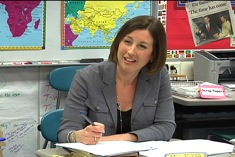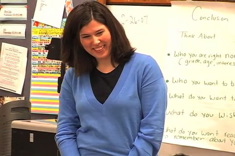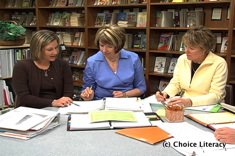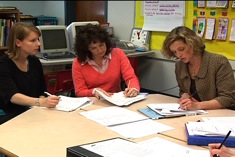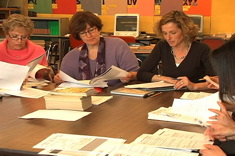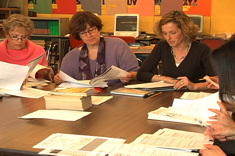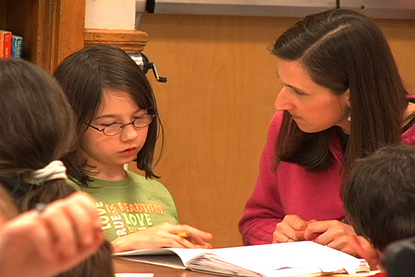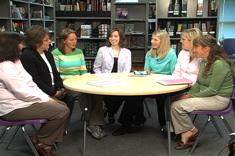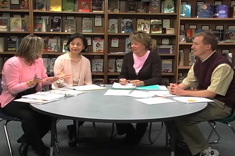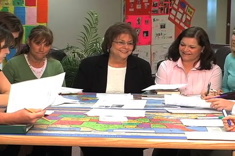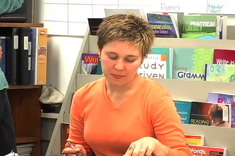Teacher Study Groups
Teacher study groups are as diverse as the teachers who participate in them. They can be an informal, low-key coffee klatch designed to relieve the daily stress of teaching. They can be highly structured inquiry groups, with detailed expectations for participants. Most study groups are likely somewhere between these two extremes, with colleagues getting together regularly to discuss books, view videos, and support each other as they test out new literacy instruction strategies in their classrooms. We include a few examples of study groups in the Choice Literacy library. If you regularly lead these groups, you'll want a membership that includes the Leaders Lounge. Here is where you will find advice from study group leaders who coordinate book groups, design workshop formats for groups, and develop structures for helping colleagues transfer the learning in study groups to the learning in their classrooms.
Latest Content
Making Data Analysis a Motivating and Worthwhile Process
Tammy Mulligan and Clare Landrigan have ideas for staying motivated while analyzing data. If you’re drowning in assessments, there are a few lifelines in this piece.
Returning to Our Creation Chambers: Supporting Experienced Teachers
Jennifer Allen reflects on her experiences as a teacher, and develops ways to help the veteran teachers she works with return to their “creation chambers.”
Using Mentor Texts in Study Groups: Play and Practice
Jennifer Allen considers ways to be more practical and playful in introducing mentor texts during study groups with colleagues.
Creating Data Teams
Literacy leaders are spending more and more time organizing, compiling, and storing assessment data, often leaving little time to analyze the findings with teachers. Clare Landrigan and Tammy Mulligan explain the value of enlisting tech support to assist with the data load.
“What I Know Now” Workshop Activity
This icebreaker from Cindy Hatt is a terrific exercise for a staff or grade-level team meeting to bring together teachers and literacy specialists this time of year. It combines individual reflection with whole-group brainstorming and goal setting.
Triangulating: The Importance of Multiple Data Points When Assessing Students
No data point for any child stands alone. Clare Landrigan and Tammy Mulligan write about the importance of triangulating data when looking at student assessments, and in the process affirm the value of classroom observations.
Mentoring from the Real to the Ideal: Mental Images of Teaching
We know the power of mental images as a strategy for helping readers comprehend difficult text. Suzy Kaback uses a similar technique to help novice teachers envision success. Thisl is an activity you might want to try with a new teacher group.
Expectations for Grade-Level Team Meetings
Tammy Mulligan and Clare Landrigan share their top tips for improving team meetings.
Self-Fulfilling Prophecies: Recommending Yourself
Suzy Kaback asks her students to write letters of recommendations for themselves, and finds that the activity ripples across the school mentoring community. This exercise is a terrific catalyst for creating personal improvement plans.
A Reason to Learn
Jennifer Allen reflects on why and how literacy leaders need to make their professional development offerings more relevant and rigorous for teachers.
From “Data Drowning” to “Data Wise”: What Are We Doing Now?
Clare Landrigan and Tammy Mulligan provide an activity for staff meetings designed to help schools sort through the purpose and value of current assessments.
Better Discussions in Study Groups
Cindy Hatt has suggestions for getting the most out of book studies with colleagues, with activities and prompts that can help you move from ideas to practice in classrooms.
Moving from Data to Practice
Clare Landrigan and Tammy Mulligan give advice for how to create databases and graphic analyses of assessment information that teachers can readily access and use.
More Teaching Metaphors
Ruth Shagoury considers her struggles with "beginner's mind" in yoga and mountain biking, and what they can both teach her about students who are struggling with any new learning.
What’s the Most Beautiful Thing You Know About…?
Ruth Shagoury and Melanie Quinn asked their colleagues to share the “most beautiful thing” about the puzzling student each of them is looking at closely in their study group. This is a great activity you’re looking for a quick and easy icebreaker to spark some positive energy in your next study group or staff meeting, and remind everyone of the joys of our profession.
Reflecting on Student Work in Staff Meetings (TEMPLATE)
Jennifer Allen describes a protocol for analyzing student work in teacher study groups and staff meetings, and includes a template for discussing classroom artifacts.
From Congeniality to Collegiality: Protocols for Meetings and Observations
Clare Landrigan and Tammy Mulligan suggest a few tested and successful protocols for meetings and study groups that foster more thoughtful conversations.
“I Used to . . . Now I”
Looking for a thoughtful and feel-good icebreaker for a staff meeting or study group? Ruth Shagoury uses the “I Used to…Now I” prompt to get colleagues thinking and talking about changes in their literacy instruction over the years, as well as where they might go next in their teaching.
Fostering More Curricular Collaboration in Teams: The Meeting Notes Form (TEMPLATE)
Katie Doherty faces daunting challenges as a grade-level team leader in her middle school. A simple notetaking form works wonders in elevating the conversations and collaboration.
Learning with Intensity: A Study Group Discussion Prompt
"Learning with Intensity" is a study group activity which takes participants back to a time when they became passionately involved with learning. Ruth Shagoury shares the structure of the activity and insights from one group who gave it a test drive.
To Fart or Not to Fart? Reflections on Boy Writers
"To Fart or Not to Fart?" was the question at the first meeting of Jennifer Allen's boys' literacy study group for teachers, and what followed was a rollicking discussion of writing, taste, and books that hook boys.
Creating Structures to Sustain Our Work
Jennifer Allen explains how she enlisted teachers to lead a day-long inservice.
Collecting Literacy Stories Icebreaker (PRINT DOWNLOAD)
If you want a terrific activity to nudge colleagues to share more of their successes and failures, you might want to download Cindy Hatt’s question templates and explanation of the collecting stories activity. It’s also a fun strategy for building listening skills and community among teachers and coaches
Team Sharing of Writing Curriculum Innovations (TEMPLATE)
Ruth Shagoury finds some of the best learning in her study groups comes when participants share the new things they are trying in their classrooms. She develops a nifty one-page notetaking form to help everyone keep track of ideas they want to test out with students.
Forming Teams to Help Struggling Readers:A Pilot Project (TEMPLATES)
Andrea Smith shares observation strategies used within a teaching team. The article includes templates developed by the group.
Connecting Language and Hope: A Study Group Activity
The teaching profession needs an abundance of hope. In this creative study group activity, Andie Cunningham helps young teachers connect language and hope through art.
Memorable Students, Memorable Teachers: A Quick-Write Icebreaker for Teacher Workshops
This is a quick-write workshop activity that is especially suited to the more relaxed pace of summer professional development workshops, or first meetings with colleagues in the fall when everyone is refreshed and reflective.
Grade Level Team Meeting: Test Preparation
In this video of a 3rd grade team meeting, literacy coaches Janet Scott and Gail Boushey help third-grade teachers think through what is going well with test preparation, and what might be adapted before the tests begin in a few weeks.
Literacy Chats with Teachers: Routines and Guidelines
Principal Karen Szymusiak explains the format and goals of literacy chats at her school, and provides a video example of a grades 3-5 chat.
January New Teacher Group Update: When Life Happens
Preparing for a forced sick day with her daughter, Jennifer Allen is reminded that the culture of professional development in her school is something she can depend on.
Browse Content By
Type
Category
- Assessment Tools
- Big Fresh Archives
- Booklists
- Choice Numeracy
- Classroom Design
- Common Core
- Community Building
- Conferring
- Content Literacy
- Digital Literacy
- English Language Learners
- Equity
- Family Relations
- Free Samples
- Guiding Groups
- Leadership
- Literacy Coaches
- Mentor Texts
- Minilessons
- New Teacher Mentors
- Podcasts
- Poetry
- Quote Collections
- Reading Strategies
- Self Care
- Struggling and Striving Learners
- Talking and Listening
- Teacher Study Groups
- Teaching Reading
- Teaching Writing
- Word Study and Vocabulary
Author
- Melissa Quimby
- Nawal Qarooni
- Gwen Blumberg
- Julie Cox
- The Lead Learners
- Hannah Tills
- Josie Stewart
- Ruth Metcalfe
- Mallory Messenger
- Becca Burk
- Jodie Bailey
- Vivian Chen
- Mary Brower
- Tiffany Abbott Fuller
- Stephanie Affinito
- Ruth Ayres
- Leigh Anne Eck
- Heather Fisher
- Shari Frost
- Julie Johnson
- Suzy Kaback
- Gigi McAllister
- Shirl McPhillips
- Melanie Meehan
- Cathy Mere
- Debbie Miller
- Tara Barnett and Kate Mills
- Tammy Mulligan
- Dana Murphy
- Bitsy Parks
- David Pittman
- Brenda Power
- Heather Rader
- Matt Renwick
- Mandy Robek
- Christy Rush-Levine
- Gretchen Schroeder
- Jen Schwanke
- Brian Sepe
- Katherine Sokolowski
- Stella Villalba
- Jennifer Vincent
Grade Level
Choice Literacy Membership
Articles
Get full access to all Choice Literacy article content
Videos
Get full access to all Choice Literacy video content
Courses
Access Choice Literacy course curriculum and training

